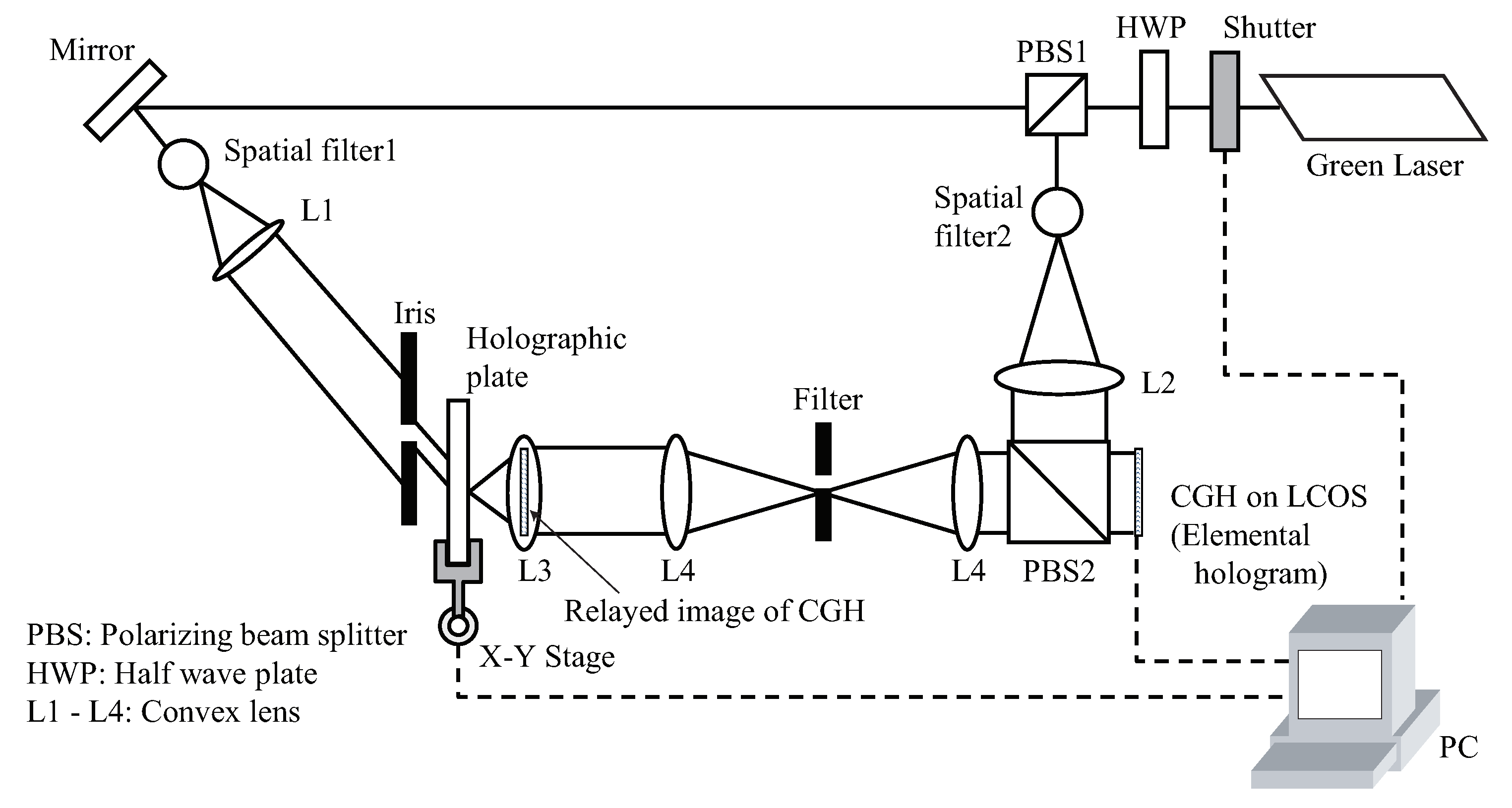Partially Overlapping Printing with Digital Filter to Improve Quality of Volume Hologram Printer – Numerical Simulation – †
Abstract
:1. Introduction
2. Volume Hologram Printer
3. Making of the Primary Plane Hologram
3.1. Calculation of the Primary Plane Hologram
3.2. Applying Digital Spatial Filter to the Calculated Primary Plane Hologram
4. Results from Numerical Simulation
5. Conclusions
Author Contributions
Acknowledgments
Conflicts of Interest
Abbreviations
| CGH | Computer-Generated Hologram |
| LCOS | Liquid Crystal on Silicon |
| SLM | Spatial Light Modulator |
References
- Benton, S.A.; Bove, V.M., Jr. Holographic Imaging; John Wiley & Sons, Inc.: Hoboken, NJ, USA, 2008; p. 270. [Google Scholar]
- Saxby, G.; Zacharovas, S. Practical Holography, 4th ed.; CRC Press: Boca Raton, FL, USA, 2015. [Google Scholar]
- Yoshikawa, H.; Yamaguchi, T. Review of Holographic Printers for Computer-Generated Holograms. IEEE Trans. Ind. Inform. 2016, 12, 1584–1589. [Google Scholar] [CrossRef]
- Yamaguchi, M.; Hoshino, H.; Honda, T.; Ohyama, N. Phase-added stereogram: Calculation of hologram using computer graphics technique. Proc. SPIE 1993, 1914, 25–31. [Google Scholar] [CrossRef]
- Kang, H.; Stoykova, E.; Yoshikawa, H. Fast phase-added stereogram algorithm for generation of photorealistic 3D content. Appl. Opt. 2016, 55, A135. [Google Scholar] [CrossRef] [PubMed]
- Yasuda, T.; Kitamura, M.; Watanabe, M.; Tsumuta, M.; Yamaguchi, T.; Yoshikawa, H. Computer simulation of reconstructed image for computer-generated holograms. In Proceedings of the SPIE Opto: Integrated Optoelectronic Devices, San Jose, CA, USA, 24–29 January 2009; Bjelkhagen, H.I., Kostuk, R.K., Eds.; SPIE: Bellingham, WA, USA; Volume 7233, p. 72330H-72330H-11. [Google Scholar]
- Matsushima, K.; Nakahara, S. Stepping closer to the perfect 3D digital image. SPIE Newsroom 2012. [Google Scholar] [CrossRef]
- Kunieda, O.; Matsushima, K. High-quality full-parallax full-color three-dimensional image reconstructed by stacking large-scale computer-generated volume holograms. Appl. Opt. 2019, 58, G104. [Google Scholar] [CrossRef] [PubMed]
- Yamaguchi, T.; Miyamoto, O.; Yoshikawa, H. Volume hologram printer to record the wavefront of three-dimensional objects. Opt. Eng. 2012, 51, 075802. [Google Scholar] [CrossRef]
- Kim, Y.; Stoykova, E.; Kang, H.; Hong, S.; Park, J.; Park, J.; Hong, J. Seamless full color holographic printing method based on spatial partitioning of SLM. Opt. Express 2015, 23, 172–182. [Google Scholar] [CrossRef] [PubMed]
- Wakunami, K.; Oi, R.; Senoh, T.; Sasaki, H.; Ichihashi, Y.; Yamamoto, K. Wavefront printing technique with overlapping approach toward high definition holographic image reconstruction. In Proceedings of the SPIE 9867, Three-Dimensional Imaging, Visualization, and Display, Baltimore, MD, USA, 17–21 April 2016; Javidi, B., Son, J.Y., Eds.; SPIE: Bellingham, WA, USA, 2016; p. 98670J. [Google Scholar]
- Ichihashi, Y.; Yamamoto, K.; Wakunami, K.; Oi, R.; Okui, M.; Senoh, T. An analysis of printing conditions for wavefront overlapping printing. In Proceedings of the SPIE OPTO, San Francisco, CA, USA, 28 January–2 February 2017; Bjelkhagen, H.I., Bove, V.M., Eds.; SPIE: Bellingham, WA, USA, 2017; p. 101270L. [Google Scholar]
- Amano, H.; Ichihashi, Y.; Kakue, T.; Wakunami, K.; Hashimoto, H.; Miura, R.; Shimobaba, T.; Ito, T.; Miura, R.; Shimobaba, T.; et al. Reconstruction of a three-dimensional color-video of a point-cloud object using the projection-type holographic display with a holographic optical element. Opt. Express 2020, 28, 5692. [Google Scholar] [CrossRef] [PubMed]
- Hua, H.; Yamaguchi, T.; Yoshikawa, H. Partially Overlapping Printing to Improve Image Quality of Volume Hologram Printer –Numerical Simulation–. In Digital Holography and Three-Dimensional Imaging 2019; OSA: Washington, DC, USA, 2019; p. W3A.29. [Google Scholar]
- Stroke, G.W. Lensless fourier-transform method for optical holography. Appl. Phys. Lett. 1965, 6, 201. [Google Scholar] [CrossRef] [Green Version]
- Waters, J.P. Holographic image synthesis utilizing theoretical methods. Appl. Phys. Lett. 1966, 9, 405–407. [Google Scholar] [CrossRef]







| Item | Value |
|---|---|
| Laser wavelength | 532 nm |
| CGH (LCOS) pixels | 4096 × 2160 |
| CGH (LCOS) pixel pitch | 4.0 m |
| Distance d between CGH and virtual window | 40 mm |
| (Focal length of L3) | |
| Virtual window width W | 4.0 mm |
| Virtual window height H | 2.0 mm |
| Offset of virtual window M | 0.2 mm |
© 2020 by the authors. Licensee MDPI, Basel, Switzerland. This article is an open access article distributed under the terms and conditions of the Creative Commons Attribution (CC BY) license (http://creativecommons.org/licenses/by/4.0/).
Share and Cite
Hua, H.; Yamaguchi, T.; Yoshikawa, H. Partially Overlapping Printing with Digital Filter to Improve Quality of Volume Hologram Printer – Numerical Simulation –. Appl. Sci. 2020, 10, 3963. https://doi.org/10.3390/app10113963
Hua H, Yamaguchi T, Yoshikawa H. Partially Overlapping Printing with Digital Filter to Improve Quality of Volume Hologram Printer – Numerical Simulation –. Applied Sciences. 2020; 10(11):3963. https://doi.org/10.3390/app10113963
Chicago/Turabian StyleHua, Hangbo, Takeshi Yamaguchi, and Hiroshi Yoshikawa. 2020. "Partially Overlapping Printing with Digital Filter to Improve Quality of Volume Hologram Printer – Numerical Simulation –" Applied Sciences 10, no. 11: 3963. https://doi.org/10.3390/app10113963
APA StyleHua, H., Yamaguchi, T., & Yoshikawa, H. (2020). Partially Overlapping Printing with Digital Filter to Improve Quality of Volume Hologram Printer – Numerical Simulation –. Applied Sciences, 10(11), 3963. https://doi.org/10.3390/app10113963






